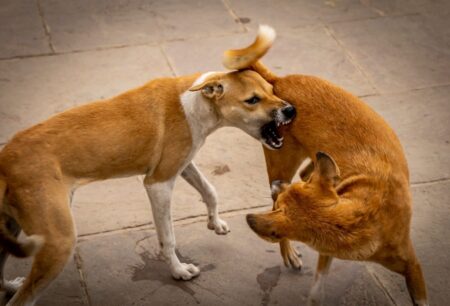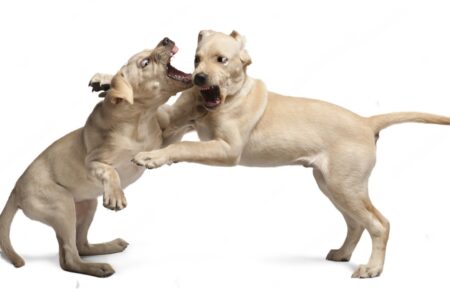How To Stop Dogs From Fighting
Every pet parent knows the horror of witnessing two of their beloved dogs fight. Not only is it a traumatic and frightening experience, but it can also be dangerous for both you and your dogs. It’s important to recognize the signs that a fight is about to start so that you can intervene before it happens. In this article, we’ll discuss how to recognize potential triggers and teach your dogs to be calm and cooperative with each other. We’ll also discuss some tips on training two dogs in the same house to reduce the amount of conflict between them, and specific techniques to use when a fight does occur.
How To Stop Dogs From Fighting
- Remain Calm: While it is important to take immediate action to stop dogs from fighting, it is important to remain calm. If you are screaming or yelling, it can actually cause the dogs to be more aggressive. Speak in a calm and reassuring tone of voice.
- Put Objects Between The Dogs: It’s important to try to separate the dogs from objects like a broom or a leash. Do not attempt to grab either of the dogs as you may get hurt in the process. Do not hit the dogs as this could make the situation worse.
- Spray The Dogs: If you have a spray bottle of water handy, you can spray the dogs in order to distract them and break up the fighting.
- Distract And Separate The Dogs: It is important to try to distract the dogs and separate them as soon as possible. If possible, have a friend help with this process. If you cannot get the dogs apart on your own, you may need to call animal control or a professional dog trainer for help.
- Reassess And Reward: After the situation is resolved, it is important to take the time to reassess the environment and ensure it is safe for both of the dogs. Praise both of the dogs for calming down and offer treats if possible.
Why Do My Dogs Fight Each Other?
Often dogs fight because of competition over resources such as food, toys, space, and attention. If there are multiple dogs in a household, it can be important to set boundaries and establish a hierarchy to reduce behaviors like fighting. Additionally, it may also be helpful to provide separate and distinct food, bed, or play areas for each dog. Neutering/spaying, separation during mealtimes, and providing plenty of exercise can all help alleviate fighting as well.
Are My Dogs Fighting or Playing?
It can be difficult to tell since it depends on the dogs’ body language and the level of their interactions. Generally, dogs will engage in more assertive wrestling and nipping when playing, while fighting will usually involve hunching, intense staring, growling, and more serious nipping. If there are signs of distress or dominance, then the dogs may be fighting. If the dogs seem to be equally enjoying themselves, they are likely playing. If in doubt, separate the dogs.
How To Tell A Dog Fight From Rough Play
When you are observing two dogs it can be difficult to tell whether they are playing or fighting. Rough play is usually a sign of two dogs playing and generally involves pushing and pulling, chasing, shallow nips, and growling. Dogs can usually tell when the play is getting too rough and will usually respond with a high-pitch yelp of submission. The biggest indicator of an actual fight is the intensity of the growling, nipping, and biting. If a scuffle becomes extended or serious, with deeper nips, snarling, and vicious biting, then it is likely that a fight has broken out.
How To Cultivate Safe Play For Dogs
- Always keep an eye on your dog when they are playing and provide supervision.
- Encourage activities that are non-contact and non-confrontational.
- Teach your dog how to play in A soft, gentle, and submissive manner.
- Use positive reinforcement methods to promote safe play behavior.
- Don’t allow rough-housing or aggressive behaviors.
- Allow your dog to take timeout breaks from playing if needed.
- Redirect any potentially aggressive behavior.
- Monitor your dog’s energy levels while playing and if needed stop and rest.
- Aim to provide a variety of activities for your dog such as ball play, tugging, chasing, interactive puzzles, and walks.
- When inviting other dogs to play ensure they have had an appropriate introduction.
Types of Dog Fights
- Illegal Dog Fights: These are the most common and most violent of all types of dog fights, in which participants bet money on the outcome of a fight between two dogs. Dogs are typically trained to fight and may be given drugs to enhance their aggression and endurance. Illegal dog fights can be very dangerous, often resulting in injury or even death to the dogs involved.
- Sporting Dog Fights: These are organized, usually Sanctioned by authorities, forms of dog fighting, in which owners bring their pets to compete in various competitions that test their dog’s agility, intelligence, and strength. Most Sporting Dog Fights provide awards and monetary prizes for winners.
- “Play Fights”: This type of fight usually occurs when two dogs are playing with each other, but manage to get too rough. In most cases, such fights do not involve any malicious intent and are resolved by the owners before things get out of hand.
- Dog Baiting: This is a form of Dog Fighting where a smaller animal such as a rabbit or rodent is placed in a small pit or ring for a dog to attack. Such fights are often used as a form of entertainment at circuses and carnivals and usually involve minimal injury to the smaller animal.
How to Stop Dogs From Fighting
- Separate the Dogs Immediately: If you witness two dogs fighting, the first and most important thing to do is keep yourself safe and physically separate the animals as quickly as possible. You can try placing a barrier between them such as a skateboard, blanket, coat, or chair.
- Remove Temptations: Removing any objects that could cause a dog fight, like toys, bones, or treats is important. Also, cleaning up spilled food and water can discourage aggressive behavior.
- Play Calming Music: Playing soft non-threatening music like classical or country tunes can help put the dogs at ease and reduce the tension.
- Implement a Leash Time-Out: If you catch your dogs fighting, take both of them outside to a secure area such as a backyard or garage and have each dog on its own leash. This prevents them from being in close contact and allows you to supervise them from a distance until the fighting stops.
- Distract Them: If the dogs are still fighting, try distracting them with a loud noise or a special treat. Oftentimes dogs will stop fighting when they hear a loud clap or whistle, or when offered a delicious snack. Don’t forget to reward calm behavior.
- Consult a Professional Trainer: If the behavior continues, seeking professional help from an animal behaviorist is the best way to teach your dogs how to peacefully interact with each other.
How to Stop Dogs During a Fight
- Calmly yet firmly call the dogs apart. Be sure to use the same command each time to help them understand.
- Make yourself large. Stand tall with your chest up and arms outstretched and make yourself seem bigger than the dogs.
- Separate the dogs using a barrier. If possible, put an object such as a broom, chair, or a rope between the fighting dogs and safely move them away from each other.
- Interrupt the fight. Make a loud noise or spray the dogs with a water hose to stop their aggression.
- Leave the scene. If the dogs are not separating, safely remove yourself from the area and allow them to separate on their own.
- Keep a close eye on them. After the fight, monitor the dogs and ensure they don’t resume aggressive behavior.
SEE ALSO: Blood Blister on Dog
How To Stop Female Dogs From Fighting
- Remove the dogs from each other to a safe environment away from triggers that may cause aggression.
- Allow the dogs a chance to cool off after separating them.
- Prevent aggression by avoiding confrontational interactions between the two dogs.
- Establish clear boundaries and establish rules that all family members should follow to ensure consistency with the dogs.
- Teach the dogs to respond to commands that are consistent and easy to remember.
- Spend quality time and positive reinforcement with each dog, such as providing treats for appropriate behavior.
- Speak calmly and confidently when around the dogs.
- Reach out for help from a professional if the behaviors still persist.
How To Stop A Dog Fight With One Finger
It may not be possible to stop a dog fight with one finger, but one can take several steps to distract and separate the dogs before the situation escalates. First, separate the dogs by placing something between them, such as a broom or a blanket. Grab the dogs by the collars, and pull them away from each other. Speak firmly and calmly to the dogs to distract them. Clap your hands or stomp your feet to draw their attention away from each other. Lastly, if possible, take the dogs to separate, quiet areas until they have calmed down.
What NOT to Do When Breaking Up a Dog Fight
- Do not attempt to separate the dogs by grabbing them while they are fighting.
- Do not scream or yell at the dogs while they are fighting.
- Do not throw objects, such as a blanket or toy, at the dogs.
- Do not attempt to separate the dogs by grabbing a leg or tail.
- Do not spray the dogs with water or other liquid devices.
- Do not attempt to pick the dogs up and take them apart.
- Do not hit the dogs in an attempt to break up the fight.
How To Prevent Dogfights
- Be mindful of your dog’s body language and be able to interpret the signs they are showing.
- Never leave two unsupervised dogs alone together.
- Spay or neuter your dog. Intact dogs are more likely to fight.
- Give your dog plenty of exercise and mental stimulation.
- Use a leash and a head halter when you are walking your dog.
- Keep your dog away from other dogs who are displaying aggressive behavior.
- Teach your dog to obey basic commands like come, sit and stay.
- Socialize your dog with other friendly dogs and people from a young age.
- Use proper introductions when introducing a new dog.
- Don’t encourage aggressive behavior.
How To Discipline A Dog After Fighting
- Separate the dogs immediately: Start by separating the two dogs from each other. Do not attempt to break up the fight yourself. Get help from someone strong and experienced, if necessary.
- Evaluate the situation: Once the dogs are separated, then assess the situation. Determine if the fight could have been caused by something you did, or if one of the dogs was the instigator.
- Check for injuries: After assessing the situation, you should check each dog for any injuries or signs of trauma. If there are minor injuries, clean and treat them as soon as possible.
- Address the behavior: After addressing the medical needs, it’s time to address the behavior. Depending on the severity of the fight, you can use positive reinforcement tools, like verbal praise, treats, and toys to show the dog what kind of behavior you want to see in the future.
- Avoid punishment: Punishment should not be used in this situation. In severe cases, punishment could cause more aggression, and result in another fight.
- Monitor the dogs better: Monitor the dogs better in the future to try and ensure that fights do not occur again. This could include more supervision, changing up the daily routine, and providing more activities to help keep the dogs active and entertained.
FAQ
Q. Can dogs live together after fighting?
A. In general, two dogs can live together after fighting, but it is important to use caution and patience. Properly introduce the dogs as if they were meeting for the first time, with both dogs on leash and supervised. If the dogs become tense or react with aggression, it is best to separate them and start the introduction process again. Increasing the amount of positive reinforcement and exercise for the two dogs can also help reduce stress and aggression.
Q. Is it normal for dogs to fight sometimes?
A. Yes, it is normal for dogs to fight sometimes. This is usually due to dominance and resource guarding and can occur whether the dogs are of the same or different breeds. It can also be a sign that the dogs are operating in close quarters and not getting enough exercise.
Q. Will dogs stop fighting on their own?
A. No, dogs will not stop fighting on their own. If two dogs are fighting, it is important to intervene and separate them as soon as possible, as fights can escalate quickly.
SEE ALSO: What Does Catnip Do To Dogs?
Conclusion
Stopping dogs from fighting takes time and patience. Start by recognizing the signs of aggression. Remove any triggers, and teach your dogs proper behaviors and etiquette. Be sure to keep your voice calm and controlled while disciplining. Be consistent with your commands and rewards. When it is not possible to stop the fight, separate the dogs and find out why they are fighting. If fights become frequent, enlist the help of a professional trainer or behavior specialist.


